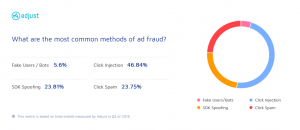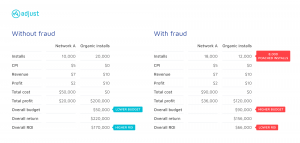 The Mobile Marketing industry has never been bigger, with ad spend predicted to reach $232.34 billion in 2019, according to eMarketer.
The Mobile Marketing industry has never been bigger, with ad spend predicted to reach $232.34 billion in 2019, according to eMarketer.
But ad fraud remains a black mark on the sector. As Adjust’s fraud prevention filters reject around one million fraudulent activities a day, we strongly believe that fraud should be every growth marketer’s priority going into 2019. Without maintaining a strong view of the problem, finding the solution becomes much harder.
Before we begin, let’s answer the basics: What exactly is ad fraud, and why should it concern growth marketers in particular?
Read More: The Fall of Organic Installs and the Growth of App-Install Ad Fraud
Ad Fraud, Simplified
Mobile ad fraud describes the actions that fraudsters commit to siphon off advertisers’ budget by exploiting mobile advertising technology.
There’s a variety of tools at a fraudster’s disposal, and each continually evolves. Fraudsters are incredibly smart, and the rewards can be huge—so, if one method is blocked, they’ll just move onto developing new ones. At present, Adjust’s Mobile Benchmarks tool shows that the most common methods of ad fraud are Click Injection (accounting for 47% of all rejected attributions), followed by SDK Spoofing and Click Spam (24% respectively), but these numbers change frequently.

Without the right fraud prevention tools in place, marketers end up practically handing their advertising budget to fraudsters on a silver platter. In some of the worst cases, we’ve seen clients lose around 80% of their budget to ad fraud. But the ripple effects of fraud, the ones which aren’t talked about, are how marketers are affected by fraud-filled datasets which influence their marketing decisions.
Read More: The Three Types of Ad Fraud Marketers Should Know About – and How to Tackle Them
What Fraud Means for Your Metrics
Ad fraud doesn’t just steal from advertising budgets—it also interferes with growth marketing decisions.
A network might look like it’s bringing tons of new installs, but there’s a chance these attributions are fraudulent. If marketers can’t tell the difference between fake and real users, they’re likely to spend more money with the ‘good’ networks—opening themselves up to further fraud. Marketers get caught in a feedback loop, directing money away from those sources that bring them real, high-quality users.
We also haven’t considered the domino effect fake users have on in-app activity and purchase data. Some marketers may not be too concerned about fake installs: In some instances, they may even view it as a good thing as their user acquisition (UA) numbers look great on paper. But other valuable metrics, such as retention and lifetime value, won’t match up, and that’ll become a serious problem down the line.
Dishonest industry players could also attempt to poach organics by using Click Spam and Click Injection methods. The table below shows the extent to which these methods of fraud could be affecting your metrics — just take a look at the difference in returns and ROI.

In an ideal, fraud-free world, a marketer could be working with a network that brings them 500 installs at a CPI of $5, the total profit of which could stand at $1,000. Alongside this, they may also gain 1,000 organic installs, from which they profit $10,000. That’s a pretty considerable ROI!
But say the network now brings an app 800 installs at a CPI of $5. That’s a big increase, which looks great at first glance. At the same time, the number of organic installs drops to 700. While it’s not impossible, it’s more likely that this particular network—or one of their sources—is using Click Spam or Click Injection to poach organic users and pass them off as their own. Marketers waste their budgets by paying for them, and their ROI drops way down.
Read More: Who’s Responsible for Solving the Billion-Dollar Ad Fraud Problem?
What’s the Solution?
While the industry may never be able to get rid of ad fraud completely, there are many approaches marketers can take to protect themselves. The most important step is the first: understanding the problem, and taking fraud seriously. A clear process and internal point person needs to be set up, fast; especially for organizations where it’s not immediately clear with whom the responsibility lies.
Growth marketers are in the perfect position to look at the numbers, see where they don’t add up, and then escalate the issue.
It’s also important to demand transparency from your partners on where exactly your ads are displayed. Fraudsters thrive off black box models, so mobile marketers need to evaluate who they partner with and ask them how they’re fighting ad fraud. It’s also a good idea to find out where and how exactly the ads are running.
Ad fraud evolves fast, so stay educated. By joining summits and workshops, keeping up to date with the news, and opening up the conversation with networks and MMPs, UA managers can gain a better understanding of potential new threats and solutions. After all, the more ad fraud is talked about the bigger a topic it becomes — bringing along better education, awareness and a sense of urgency to the issue.
Read More: The MarTech Fitness Drill 2019: How Much Do You Sweat With Your Marketing Technology











